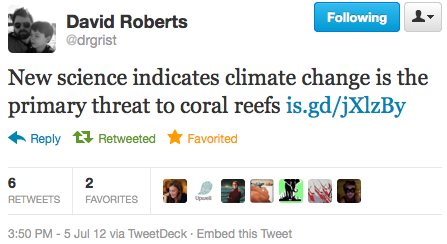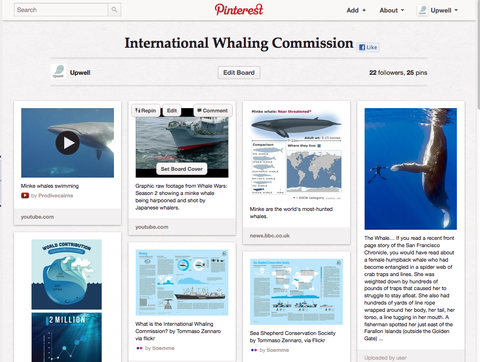Blog Feed
Attention Lab Digest - Week of July 2
Despite the oddity of the mid-week holiday, Upwell had a busy week. We more than doubled in size, too! On Monday, we were joined by our newest full-time staff member, Matt Fitzgerald, and on Thursday, three interns joined the Upwell crew. You can read more about them here, and you can follow our intern team on twitter at @UpwellINTERNS.
We sent out three Tide Reports last week (miss them? check out our archives.) and are super thrilled with some of the resulting amplification.
What Makes a Toolkit Tick?
On Tuesday morning, we shared some additional unpacking we did of the Rio+20 conversation, and shared news about the International Whaling Commission's decision against a South Atlantic Whale Sanctuary. We shared our toolkit again, which garnered a few mentions on Twitter. The part of Tuesday's Tide Report that got the most attention was our very own Kieran Mulvaney's blog post on Discovery News - When Orcas Attack. Miriam Goldstein tweeted about it and it was retweeted several times.
Lessons: Overall, there was not very high traffic to our toolkit. We still like toolkits and are pondering how to make them more useful in the future, and will try to prep them more in advance. The content that was most amplified was the most liquid - a video and story about the incredible cooperative attack efforts of Orcas. We'll try to include more amplification ideas around these slippery topics in future Tide Reports.
Our First Ever High Tide Alert
On Tuesday afternoon, we were discussing what content would go out in Thursday's Tide Report, including some information about the shark fin soup ban at China's official banquets. That piece of news was already being shared widely, and we noticed that the conversation about it was still on the rise:
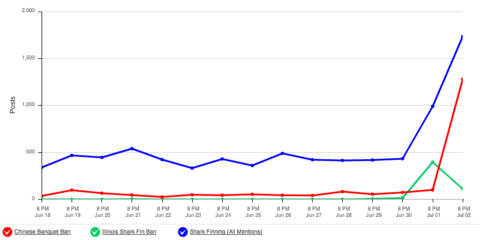
Seeing an opportunity, we decided to send out a "High Tide Alert," with ideas for our readers about how to jump into the conversation and make shark-friendly content spread even wider. We put together an image that played on a familiar internet meme with suggestions on how best to share it on Twitter and on Facebook.
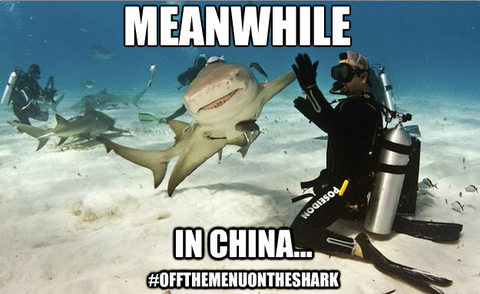
We couldn't have prepared ourselves for the results. Mission Blue posted the image shortly thereafter on their facebook wall, and it has since received over 1,500 shares and over 1,000 likes. The "Talking About This" metric on Facebook aggregates all comments, shares and likes. This post had over 7,200 people talking about it, which was more than double the number of people talking about all of Mission Blue's posts from the last month combined. The page received hundreds of new likes in the same period as well. Thank you so much to Deb Castellana for sharing these metrics with us!
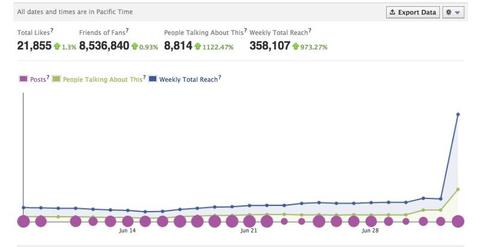
Lessons: Never underestimate the power of a meme! Especially on facebook, image macros that have visual impact and also include a message or story have high virality. Because the message is contained in the image, it remains with it as it is shared widely. The fact that Mission Blue, which already has nearly 22,000 followers on facebook, shared the image, got it off on the right foot. Also, the story was about China and was surprising in its own right, and that contributed to the shareability.
Interesting, but Not Necessarily Shareable
We are on a long quest toward finding the secret sauce that makes something that is interesting shareable. Thursday's Tide Report was an example of interesting content that didn't get amplified. People clicked on all the links in the email, but little was then amplified. Do you think you know an ingredient to the secret sauce? Email us and tell us.
Coral Reefs and Climate Change
Did you see the new study about coral reefs and climate change? It was covered by the AFP, the NY Times and Discovery News. John Bruno tipped us off to the study early Friday morning, and then later posted his own take on the story on the SeaMonster blog. The study seemed to have two real takeaways: climate change poses a HUGE threat to coral reefs, and coral reefs have the ability to potentially recover. There seemed to be a real risk in focusing on the latter, so we shared the study and John's analysis with climate blogger David Roberts at Grist. Why him? Because he's got a pretty level head about the whole climate change thing, isn't afraid to speak his mind, and is a true engager online, participating in conversation.
Moments after our email, David shared the link, with the right message. With the help of his voice and those that retweeted him, this study reached another potential 23,000 people with the right message.
Attention Lab Digest - Week of June 25 (and bigger transitions)
Since March, we've been busy testing our assumptions about social media outreach by running our own experimental micro-campaigns. We've been monitoring online conversations and ocean news to learn what people are talking about and how they are talking online, and then devising outreach activities that would increase attention to high-quality, science-based content (and the occasional meme-worthy silly animated gif).
We've been tracking our success through diligent metrics, and we've learned lots. We've chronicled those lessons here on our blog.
We are transitioning.
At the end of the day, though, there are hundreds of voices - nonprofit organizations, academic institutions, and motivated marine evangelists - who have the tools at their disposal to do this kind of work more effectively than we can. This network of marine conservationists and ocean lovers has a broad audience, spanning from surfers to engineers to divers to eco-activists. The most social media-savvy of the bunch have cultivated a lively conversation with these audiences. We believe that ultimately, in order to effectively raise attention to ocean issues online, we must provide the tools, analysis, resources, and ideas to this network rather than attempting to do it all on our own.
We are conditioning the climate for change.
Our aim is not to amplify the bumps in attention - it is to raise the baseline of conversation overall. We are doing this by activating a network, rather than by trying to be a voice for a network.
We assume many to many, not one to one. We work together.
/index.jpg?itok=m7KapC9R)
The Tide Report
We have started to test this through our Tide Report, a newsletter that goes out to the marine communications network. Through the Tide Report, we are:
- applying our data analytics and scraping abilities to identify the hottest conversations and understand the dynamics of those conversations.
- applying our curation skills to find the most liquid, shareable content.
- applying our campaigning skills and lessons to identify easy pathways to amplification.
- embedding metrics, so we can track what works, what resonates, and what is most useful to the community.
Wrap-Up From Last Week
Last week, we sent four tide reports. Our list may still be growing, but we are already starting to gather some useful metrics.
On Monday, we shared news about ocean acidification on the California coast that Ocean Conservancy's George Leonard flagged for us. Thank you George! (Have a tip for us? email it to tips (at) upwell.us.) We encouraged people to share a video that shows a visualization of these changes in acidity, as well as our image macro we had created the prior week. (An image macro is an image with overlaid text. They do very well on the internet.) The video was shared by our readers Ayana Elizabeth, Miriam Goldstein, Jen Savage and Julia Roberson.
Lessons: Video and image sharing are more popular than news sharing. A captivating visual of a complicated issue helps marine advocates simplify their message.
On Wednesday, we shared a round-up of sustainable seafood news: the London Olympic Committee's sustainable seafood commitment, the rise of community-supported fisheries (CSFs), an article in Fast Company about the most sustainable seafood (phytoplankton) and greenwashing by a French retailer. We also shared our own blog post about the Cabo Pulmo marine reserve as well as our take on the North Carolina sea rise saga. We asked people to share a link roundup compiled by John Bruno from the SeaMonster blog. Folks were eager to share his link roundup (because it's awesome!) and also shared the CSF locator with their friends.
Lessons: Both of the most-shared pieces in this tide report were useful resources. While we at Upwell are always looking for catchy, visual content, we mustn't lose sight of the high-quality resources that help consumers of news and seafood do it more smarter.
On Thursday, we shared some news about sharks, NRDC's recently released beach quality studies, and a fun image of a seal clubbing a seal clubber. The piece that received the most clicks was a link to retweet David Shiffman (@WhySharksMatter) and share the news about the shark study. Our friends at Conservation International helped to amplify the news and direct attention to David. Thanks, CI!
Lesson: People like to share and echo those in their community. We will be providing pathways to amplification that bolster the ties within the marine community.
Over the course of the week, we also did some of our own outreach. We reached out to food bloggers who might be interested in writing about CSFs, and shared with them the localcatch.org resource we shared in Wednesday's newsletter. We also reached out to some tech bloggers to share with them the very cool but undershared news about the SeaOrbiter, an underwater research vessel that looks like an awesome space ship. Look out for some potential blog articles coming down the pike from Grist and Popular Science.
Attention Toolkit: All You Need to do the IWC Thing Right on the Internet
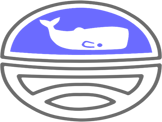
The International Whaling Commission meets in Panama July 2-6. Look for a rundown of the issues in tomorrow's Tide Report.
The toolkit below was built to make it easier for you to amplify the IWC conversation online.
We like feedback.
This toolkit is a living, breathing thing, so feel free to send us suggestions for additions and alterations.
Also, let us know what this tooklit helps you do, and we'll repay the favor by driving more attention to your content.
Ideas for online content:
- Storify key tweets
- Clog a backgrounder and a wrap up with great photos. Just kidding. *Blog* that stuff.
- Use Twitter to track down a hot Skype interviewee
- Use an image and do a text overlay to evoke conversation on Facebook
Voters in the U.S. strongly oppose commercial whaling and want the U.S. to enforce whaling bans, but many do not know that countries like Japan, Norway and Iceland are still killing whales. Many don't know it's a problem. Share image macros and quotes that help to overcome this lack of knowledge. The American Cetacean Society does that here.
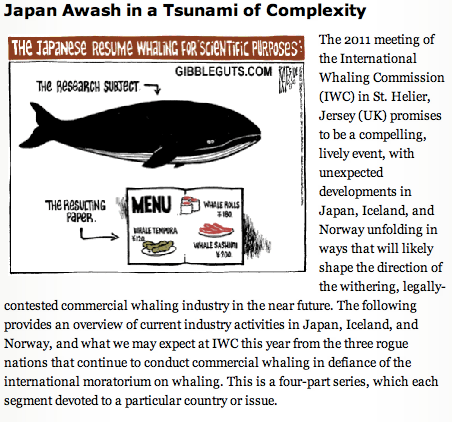
Whaling and IWC-Related Images and Videos to Amplify
We have curated photographs, infographics, and videos that bring the whaling issue to life on an IWC Pinterest board. Use these graphics and videos on your website, your facebook and twitter feeds, and your own Pinterest boards, but don't forget to attribute them! Heads up: many have restricted licenses.
Want to pin to our board? Awesome. Email us.
Upwell's IWC Pinterest board. Images to consider for posting to Twitter, Facebook and using in blog posts.
More Recent Whaling News (to use as a hook)
Greenland's Whale Meat Going More to Tourists Than Locals (Treehugger, June 26)
Seventy-Five Percent of Japanese Whale Meat 'Unsold' (Telegraph, June 14)
Whale Sanctuary Bid Falls Short (BBC News, July 2)
On Twitter
Hashtags to Watch and Use
- #IWC2012 (This is the one we'd recommend. That wine thing is so over.)
- #IWC64
- #savewhales
Who to Follow
Upwell has compiled an IWC 2012 Twitter list of people who will be tweeting from the meeting.
Want to be part of it? Have other suggestions? Let us know. If this list had a hundred people on it, we wouldn't complain.
Organizations Active at IWC
- American Cetacean Society. On the web. On Twitter. ACS's IWC blog.
- Animal Welfare Institute. On the web. On Twitter.
- Environmental Investigation Agency. On the web. On Twitter. EIA's blog from the meeting.
- Greenpeace. On the web. On Twitter. On their IWC 2012 Tumblr. On the web: IWC 2012 page.
- Humane Society of the United States/Humane Society International. On the web: HSUS / HSI On Twitter: HSUS / HSI. Read their opening statement.
- International Fund for Animal Welfare. On the web. On Twitter.
- Natural Resources Defense Council. On the web. On Twitter
- NOAA. On the web. On Twitter.
- Whale and Dolphin Conservation Society. On the web. On Twitter.
- WWF. On the web. On Twitter.
Background Information and Documents
- The International Whaling Commission's meeting homepage.
- A list of all available documents being presented at the meeting.
- NOAA's IWC 2012 page.
- ECO, the daily newspaper produced during the meeting by NGOs.
- The International Fund for Animal Welfare's Blueprint for U.S. Whale Conservation.
- IFAW's background briefing on the South Atlantic Whale Sanctuary
- An EIA briefing for the IWC on marine debris.
- A poll on U.S. attitudes toward whales and whaling
- Text of a bill introduced to the House of Representatives on June 28, expressing support to end commercial whaling and strengthen measures to conserve whale populations.
See the Sea. See the Sea Level. See the Sea Level Rise.
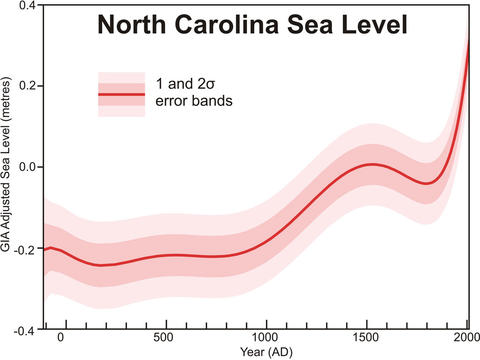
Graph showing sea level rise along North Carolina coast, adapted from Kemp et al, via Skeptical Science
"From Cape Hatteras, N.C. to just north of Boston, sea levels are rising much faster than they are around the globe," reports Seth Borenstein of the Associated Press:
Along the region, the Atlantic Ocean is rising at an annual rate three times to four times faster than the global average since 1990 ... It's not just a faster rate, but at a faster pace, like a car on a highway "jamming on the accelerator," said the study's lead author, Asbury Sallenger Jr., an oceanographer at the [United States Geological Survey] ... By 2100, scientists and computer models estimate that sea levels globally could rise as much as 3.3 feet. The accelerated rate along the East Coast could add about 8 inches to 11 inches more, Sallenger said. "Where that kind of thing becomes important is during a storm," Sallenger said. That's when it can damage buildings and erode coastlines."
Any pragmatic, concerned local authorities along the eastern seaboard would be looking to prepare for the worst-case-scenario, surely? Wellll, not so much, especially in North Carolina.
The ongoing discussion in the Tar Heel State to legislate away sea-level rise has been well documented over the past couple of weeks (Cliff Notes version: Some state lawmakers want to ban coastal planners from using scientific models that show accelerated rises in sea level), and has even been the target of primetime televised mirth:
At least the state House last week rejected a bill passed by the Senate, which would have forbidden the use of accelerated sea-level rise predictions in coastal planning. Not that the story is necessarily over: some lawmakers countered that they might instead float the idea of a five-year moratorium, rather than an outright ban, pending a review of the available science.
It is to the misfortune of the wish-it-all-away members of the North Carolina legislature that the Raleigh-Durham-Chapel Hill Research Triangle is home to several individuals and institutions with a knowledgeable focus on ocean issues, several of whom are more social-media savvy than the average bear. The folks at Southern Fried Science, for example, posted a short explanation of precisely why a linear extrapolation of sea level rise trends, as advocated by supporters of the Senate bill, is the absolute least reliable predictor of future changes. The man who has really been pounding away at the issue, though, is UNC's John Bruno, via his SeaMonster blog. John has a summary of the state-sponsored scientific report on sea-level rise that sparked the frenzy, rebuts an attempted rebuttal of the scientific arguments against the Senate bill, and is posting regular updates on the legislation's progress or lack thereof, of which this is the latest.
Saving Cabo Pulmo. Again.
Looking for something upbeat to share?
This is a story about environmental heroism and conservation success. Plus, there's pictures of jumping devil rays. Can't beat that.
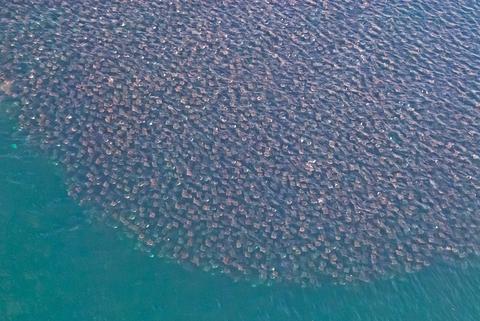
Aerial view of devil rays in Cabo Pulmo. Photos by Octavio Aburto-Oropeza/iLCS
There's nowhere quite like Cabo Pulmo. Measuring just 14 km by 5 km, this small patch of coast in the Gulf of California has been dubbed 'the 'most successful marine reserve in the world.' Established in 1995 largely at the behest of the 100 or so residents of a nearby village, it nearly became a victim of its own success, until the villagers once again interceded on its behalf.
For the first ten years of its existence, the reserve's existence made no measurable impact on the wildlife within its boundaries; after a decade or so, however, that all changed. Overall fish biomass in the reserve increased by 400 percent. Check out, for example, the aerial photograph above of devil rays. "You can't even really see from this photograph, but the rays are four or five deep in places," Grant Galland of Scripps Institution of Oceanography, co-author of a paper about the reserve, told me last year. "You couldn't possibly get an accurate count from underwater."
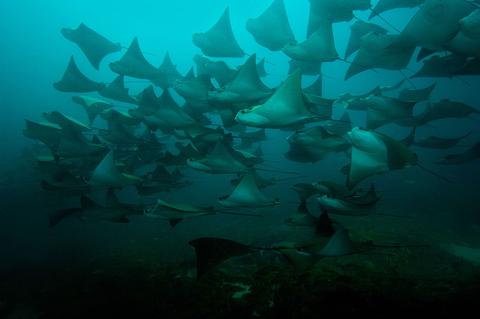
The rays are four or five deep in places.
Exactly why Cabo Pulmo has been so successful is not entirely clear. However, two factors of success, are quite clear. It was established, and is enforced, by local residents; and the few commercial activities that are permitted - tourism, fishing on the reserve's fringes - are small-scale. However, the lure of potential pesos soon proved too much for the commercial tourism industry, and specifically the Spanish company Hansa Urbana, which sought to built a mega-resort called 'Cabo Cortes.' The resort would have comprised a 3,655-room hotel, two golf courses, a marina, shopping centers, and a private airport, and would have consumed water equivalent to that used by 183,000 people daily for 30 years.
Cabo Pulmo: Where conservation and quality of life aren't mutually exclusive
The establishment of the reserve was not without its difficulties, notes Octavio Aburto-Oropeza, who took these photographs: "The people from Cabo Pulmo suffered. It was not easy. The transition to other employment sources, other than fisheries, the economic crisis, and the new regulations as part of the identity as a Marine Park represented great challenges, with high costs." However, they persevered, to the extent that they "now have a quality of life superior to that of any other artisanal fishing community in the Gulf of Mexico." So much so, in fact, that they, in concert with a variety of environmental NGOs, took the lead in actively opposing the development of Cabo Cortes, choosing long-term investment in their natural surroundings over the lure of potential short-term profit. That opposition proved successful when, earlier this month, Mexican President Felipe Calderon announced his government would not permit the building of the resort, determining that Cabo Pulmo is Mexico's most important reef and in need of full protection.
Tweeted Enric Sala of the National Geographic Society: "Despite popular pressure and president's decision, the real hero of this story is the local community."
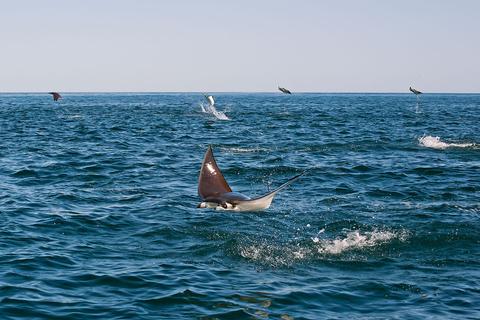
Want more? View an annotated slideshow of Octavio Aburto-Oropeza's Cabo Pulmo images at Discovery Channel News.
